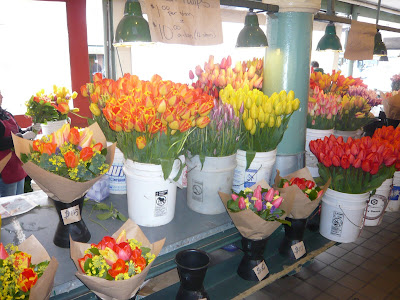
Downtown from West Seattle

Tulips in bloom

Composer makes his selection

Olson Sundberg's early Pike Market building

Beautiful detail
Situated between two bodies of water and several distant mountain ranges, the city connects to nature in a way most American cities don’t. REI defines fashion, not Abercrombie & Fitch. If it’s sunny, even with a chill in the air, the café windows are all open and the shirts come off. On especially warm days, everybody takes the afternoon off to go hiking, cycling, or kayaking. It is a physical city, not a lethargic one.
In the last few years, mid- and high-rise apartment houses have sprouted all over downtown and the adjacent neighborhoods. Unlike in a lot of American cities, affordable and low-income housing has long existed side by side with more expensive units. The design rarely reaches the standard of that early Olsen Sundberg building at Pike Place Market; the new stuff is mostly bland if inoffensive. At least the postmodern phase was blessedly brief. The density, combined with the turn of a generation, may have done something else dramatic here. The populace voted for rail – at last. Coming in from the airport, we saw an elevated track and transit stations. It’s a good thing, because the freeway situation approaches LA gridlock.
The monorail, that first piece of elevated rail built for the 1962 World’s Fair, is now a nostalgia trip, travelling a few blocks from Seattle Center to downtown. It looks like a toy, with exaggerated fin details on the base of the cars. Maybe if the monorail had actually gone somewhere, people would have believed in rail? When I first started visiting the city regularly, people seemed to go all over the city, but now people say they don’t ever get to this or that neighborhood. Given the traffic, this is understandable, because most of the neighborhoods are walkable and feature local businesses and great restaurants – and fantastic bakeries!

Macrina Bakery - more baked goods!
Our weekend started in a bakery on Capitol Hill, where my friend Kristina was showing her woodblock prints of Mount Rainier, inspired by Hokusai’s famous prints of Mt. Fuji. Interestingly enough, a bakery was a great place for friends and school chums to mingle. None of that white wall pretentiousness that accompanies most art receptions. Very Seattle. Check out Kristina’s prints at www.kristinahagman.com.

Kristina Hagman's art show. Woodcuts of Mt. Fuji and yummy snacks.
The city’s new triumph is the Olympic Sculpture Park, created by the Seattle Art Museum (known as SAM). In the great tradition of Lawrence Halprin’s downtown freeway park, this new urban oasis bridges a major roadway and the railroad track taking visitors from Belltown down to the waterfront. The treasure of the park is Richard Serra’s Wake from 2004, where you are transported into an environment that is weightless and heavy at the same time. The sculpture Love & Loss by transplant Roy McMakin invites you to use it for a picnic.

SAM Olympic Sculpture Park entrance

Olympic Sculpture Park

Richard Serra in marching order

Serra detail

Trains as moving sculptures

A family makes use of Roy McMakin's sculpture
As brilliant as the Olympic Sculpture Park is, the new Seattle Art Museum is disappointing. There was a lot of local pride when Robert Venturi’s first phase opened in 1991. But the cognoscenti saw the tail end of postmodernism, and when it came time to expand the building, the commission went to the American museum architect of the moment, Brad Cloepfil and his firm, Allied Works Architecture. Cloepfil tried hard to create a subtle take on the corporate office tower that dominates the site, but his timing was unfortunate. Coming on the heels of Rem Koolhaas’s radical new public library, SAM felt like a quiet corporate afterthought. And Venturi’s overscaled grand staircase has been all but forgotten. It was always too large, but it was the best part of the building, and now it feels like the space left behind. However, the combined galleries are relatively seamless and capacious.
We stopped by the Frye Art Museum designed by Olson Sundberg, which was between shows. It was looking a little worn, but the metal detailing still looked pristine. It is a wonderfully sized museum, perfect for personal collections or small shows. And it has its own free parking lot!
Seattle is a proud city that doesn’t take itself too seriously and isn’t afraid of some experimentation. I am not in love with all of the spaces in the new library, but it’s hard to imagine a public building like that ever getting built in San Francisco.
Our excuse for this trip was the premiere of Paul’s new piece about Columbine entitled “Meanwhile,” performed beautifully by Eric Banks’ group, the Esoterics (www.theesoterics.org). Paul set a portion of Simon Armitage’s poem “Killing Time.” One of the soloists, Christine Bell, was in choral practice on the day of the Columbine tragedy, and her comments gave a special poignancy to the series of concerts. Although the acoustics were slightly better at Holy Rosary in West Seattle, I prefer the poured-in-place concrete St. Joseph’s over on Capitol Hill, a short walk from Kristina’s house. It feels more coherent as a piece of art 1930s art moderne architecture. More meditative, even a bit spooky.

Three composers and a conductor

Yosh and Vale at the Seattle concert

Paul after the Seattle concert

Paul and Carmen reunite after a few years
Although everybody tells me that Starbucks own Top Pot doughnuts, I still confess to a weakness.… When you are tapping away at the keyboard in the one on Capitol Hill, you feel like a real writer.

Boys night out.

Relaxing at the Masler's



No comments:
Post a Comment